Westside Toastmasters is located in West Los Angeles and Santa Monica, California
Chapter 2
THE SOCIAL LEVERAGE IN ACTIVE HAND GESTURES

No weapons concealed here! Centuries ago exposed open hands indicated a lack of evil intent.
Among all species, our human hands are unique -- not only in what they can accomplish, but also in how they communicate. Human hands can play a violin, maneuver surgical instruments, frame a house, fold paper into origami, and paint the Sistine Chapel. They can grasp, scratch, poke, punch, feel, sense, evaluate, hold and mold the world around us. Our hands are extremely expressive; they can sign for the deaf, help tell a story, or reveal our innermost thoughts.
Despite the acquisition of spoken language over millions of years of human evolution, our brains are still hard-wired to engage our hands in accurately communicating our emotions, thoughts, and sentiments. The hands have been the most important tools in human evolution and there are more connections between the brain and the hands than between any other body parts. Therefore, whether people are speaking or not, hand gestures merit our attention as a rich source of nonverbal behavior to help us understand the thoughts and feelings of others.
Our brain gives a disproportionate amount of attention to the fingers, and hands, as compared to the rest of the body. This could be in part because our first touch is with our hands and we seek the hands of our parents for safety or it is because the human hand can hold a weapon. For whatever the reason, we tend to focus on the hands and are mesmerized by them.
You're born to speak with your hands. Researchers have found that infants who use more hand gestures at 18-months old have greater language abilities later on. Hand gestures speak to great intelligence.
Using hand gestures early in life can predict that a child will later develop a strong vocabulary, as well as skills related to sentence structure and storytelling, according to a study published in the Journal of Child Language.
For the study, researchers asked 6-year-olds to relay what was happening in a cartoon. They asked the children to repeat the task when they were 7, and again when they were 8. The children's ability to structure a narrative improved over this time period - and children who had expressed a character's viewpoint using hand gestures at age 5 were more likely to tell better-structured stories later in childhood.
Another study found that forcing children to gesture while they explained how to solve math problems actually helped them learn new problem-solving strategies.
Second only to your face, your hands are your most visually expressive feature and can be equated to your voice because they can convey so much. They serve as a substitution for words as well as supporting the spoken word by illustrating and amplifying what you're saying. When you're giving directions to someone who's lost, you most likely use your hands to get them heading on the correct route. When you're emphasizing a point your hands move in time with your words. When you're describing a shape or a particular scene your hands create a visual picture of what you're saying. These kinds of hand gestures make complicated explanations more comprehensible.
Hiding Under The Covers
When you conceal your hands by putting them behind your back or shoving them in your pockets, it's like keeping your mouth shut. What your hands are indicating is, 'I don't wish to speak!'
Imagine yourself back in your childhood. You've just been caught with your hand in the cookie jar. You quickly pull it out and stick it behind your back as children often do while lying or concealing something while saying, 'I didn't take anything!' And all the time your hand stays hidden.
Fast forward to life now. Hypothetically, you've been out on the town with your buddies, you arrive home as the sun is rising, and your "significant other" asks your whereabouts the night before. Rather than owning up to the indiscretion, major or minor, if you're a man you may well shove your hands into your pockets or cross your arms with your hands tucked neatly away while spinning your fairy tale. If you're a woman you busy your hands with a flurry of activities while conveying your excuse. Either way your palms stay hidden.
Signaling Openness
Throughout history, the open palm has been associated with truth, honesty, allegiance and submission. Many oaths are still taken with the palm of the hand over the heart, and the palm is held in the air when somebody is giving evidence in a court of law; the Bible is held in the left hand and the right palm held up for the members of the court to view. One of the most valuable clues to discovering whether someone is being open and honest - or not - is to watch for palm displays. Just as a dog will expose its throat to show submission or surrender to the victor, humans use their palms to display in a similar way to show that they are unarmed and therefore not a threat.
When people want to be open or honest, they will often hold one or both palms out to the other person and say something like, 'I didn't do it!', 'I'm sorry if I upset you' or 'I'm telling you the truth'. When someone begins to open up or be truthful, they will likely expose all or part of their palms to the other person. Like most body language signals, this is a completely unconscious gesture, one that gives you an 'intuitive' feeling or hunch that the other person is telling the truth.
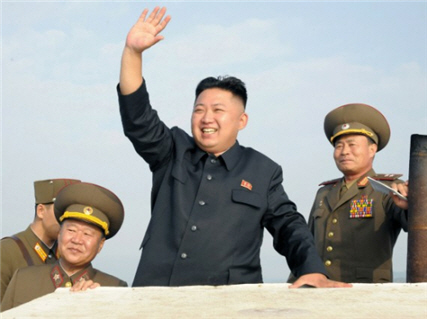


The palms are intentionally used everywhere to infer an open, honest approach
Salespeople are taught to watch for a customer's exposed palms when he gives reasons or objections about why he can't buy a product, because when someone is giving valid reasons, they usually show their palms. When people are being open in explaining their reasons they use their hands and flash their palms whereas someone who isn't telling the truth is likely to give the same verbal responses but conceal their hands.
Keeping their hands in their pockets is a favorite ploy of men who don't want to participate in a conversation. The palms were originally like the vocal cords of body language because they did more 'talking' than any other body part and putting them away was like keeping one's mouth shut.
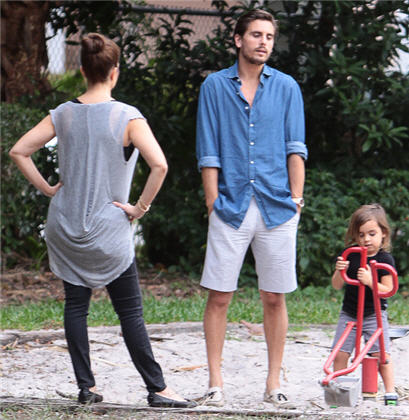
Palms in pockets: The posturing suggests she is making her point forcefully and he is in the doghouse ... and doesn't feel like communicating
Conscious Intent To Deceive With Hands
Some people will wonder, 'If I tell a lie and keep my palms visible, will people be more likely to believe me?' The answer is yes - and no.
Con artists, professional liars, and used car dealers know the tricks of the trade and use the open palm gesture when trying to convince you that they're genuine and sincere. However, If you tell an outright lie with your palms exposed, the listener can still detect that something's not quite right because other gestures of honesty are absent, such as open facial expressions, calm breathing, and a relaxed stance, are missing. That incongruence in gestures will ring alarm bells ring as your instincts cry out, 'Wait a minute, what this person is saying IS a lie!'. The more effectively the professional con artists can synchronize the body language of honesty when telling their lie(s), the better they are at their job.
It's possible, however, to appear more open and credible by practicing open palm gestures when communicating with others. Interestingly, as the open palm gestures become habitual, the tendency to tell untruths diminishes. Most people find it difficult to lie with their palms exposed because of the law of cause and effect. If a person is being open they'll expose their palms, but just having their palms exposed makes it difficult for the person to tell a convincing lie. This is because gestures and emotions are directly linked to each other. If you feel defensive you're likely to cross your arms across your chest. But if you simply cross your arms you'll begin to experience defensive feelings. And if you are talking with your palms exposed it puts even more pressure on the other person to be truthful too. In other words, open palms can help to suppress some of the false information others may tell and encourage them to be more open with you.
Open Palms Ask For Trust
The open hand is an ancient sign of trustworthiness. It's a positive position and is helpful for establishing rapport with another person. It is also a submissive, non-threatening gesture reminiscent of the pleading gesture of a street beggar. Over the course of history in different cultures it has served as a simple signal that one does not have a weapon to readily use.
One way to gauge if someone is being honest with you look at where her palms are facing. If one or both of the palms are facing up it's a decent sign that you're hearing the truth. When people hold their hands in a front facing open position the words that would capture the essence of this position would be along the lines of, 'You can absolutely trust that I'm telling you the truth.'
One of the least noticed, but most powerful, body signals is given by the human palm when giving someone directions or commands and in handshaking. When used in a certain way, palm power invests its user with the power of silent authority.
The palm up gesture became modified over the centuries and gestures like the single palm raised in the air, the palm over the heart and many other variations developed.
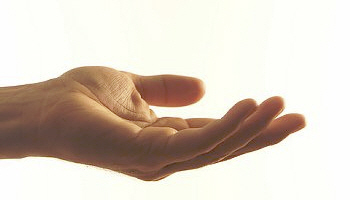
Palm up = non threatening

Angela Merkel, German leader in a palm down display of authority and power
The Downward Facing Palm
Turn your hand over with your palm facing downwards and you're projecting power and authority. This position is used for giving orders where little room exists for discussion. Gesturing with your palm facing downwards says, 'I'm in control here. Do as I say!'
You have to be careful when using this gesture, especially if your fingers are tightly closed because of its historical association with tyrannical power in Nazi Germany. Hitler instinctively understood the intimidation this salute gesture conveyed.
If someone on the receiving end of this gesture has equal formal status they may well feel resistance to what is being said. If the person in a dialogue is your subordinate, the palm down gesture would be seen as more acceptable given the uneven balance of power.
Paradoxically, if you want to cool down a tense situation or ask for quiet, you can moderately alter the palm down gesture by holding out both your palms slightly pointed downwards with your fingers slightly separated and gently beat them up and down. Make sure that your fingers are relaxed or you will negate a good degree of the effect.

Adolf Hitler using one of history's most renowned hand signals
Power Moves
Closed Hand With Finger Pointed
Close your palm into a fist, point your index finger, and you've just created a metaphoric club for beating anyone close by listening into submission.
Think back to a time when someone - a parent, teacher, or an executive above you - pointed a finger at you. You know then how threatening and aggressive that gesture can feel. That is because it comes from our primate ancestors who shake their clench fists just prior to pummelling their opposition into submission with an over-arm blow. In some Asian countries finger pointing at a person is an insult as this gesture is only used to point at animals.
A variation on the gesture that may prove even more annoying is when the pointed finger oscillates up and down, even synchronized in rhythm with what is being said. It may make you feel like a badly behaved child being reprimanded.
A close cousin, the finger jab has a forward stabbing motion. Not one of the most conciliatory of gestures, use it with great caution.
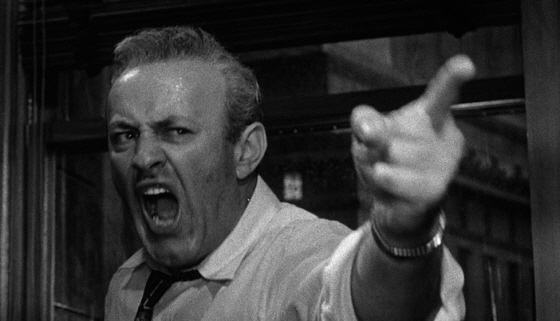
The closed hand, with pointed finger is threatening and aggressive, 'Do it or else!'
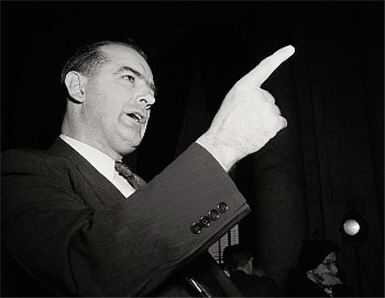
The pointing finger creates negative feelings in most listeners
Experimentally, finger pointing not only has very low positive impressions in listeners, the absurdity is that listeners recall significantly less of what the speaker has said, the opposite of a speaker's intent using that gesture. If you are a habitual finger-pointer, try practicing the palm-up and palm-down positions and you'll find that you can create a more relaxed atmosphere and have a more positive effect on others.
The Precision Thumb, Fingertips Grip
A much more benign alternative to a pointed finger is to squeeze your fingers against your thumb to make an 'OK' type of gesture and talk using this position, you will come across as authoritative, but not aggressive. Hold something small between your thumb and fingertips. It can be a pen, a needle, or a delicate piece of fabric. This is a precision grip, which allows you to hold and manipulate an object precisely. Now, when you're speaking and want to say something accurately or delicately press your fingers and thumb together in a similar position with your palm facing towards you. Presto! Your listener understands that you're reinforcing what you're saying with great precision and accuracy.
This gesture tactic has been taught to speakers and business leaders with good success as measured by audience reactions. The audiences who listened to the speakers who used the fingertip-touch gestures have described those speakers as 'thoughtful', 'goal-oriented' and 'focused'.
In some countries the okay signal is considered rude. Before making any definite gesture find out what is acceptable behavior and what may cause offense.
When you ask a question or are feeling uncertain about a point you're making or responding to, you may well find that your thumb and index finger are almost - but not quite - touching. Funny how that happens, as if the fingers know that the answer isn't quite there. When the fingers do come together in a definite grip it's as if they've grabbed the information and are holding onto it.
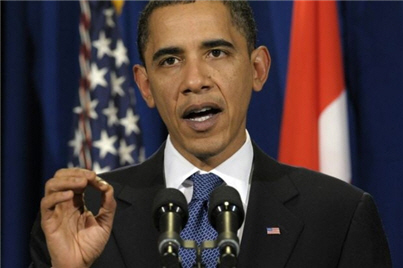

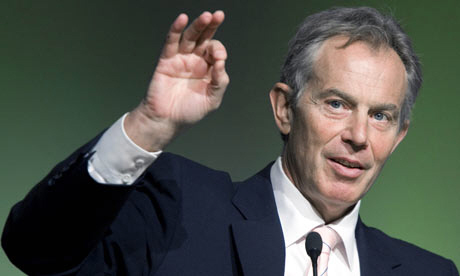
Squeezing the thumb against the fingertips avoids intimidating the audience
The Fist Thrust
Another in the arsenal of authoritative gestures where you want to achieve maximum impact is thrusting out the fist. People who want to be perceived as strong, serious, and forceful employ this move. It's as if they are holding onto a strap on a fast moving bus or train, or hammering a nail into a piece of lumber.
You can use this gesture effectively in two ways. If you choose to deliver your message in a mild mannered way, leave your fingers bent, not fully closed. If, however, you intend to take no prisoners, close your fingers into the fist.
Watch a public speaker or politician who deliberately wants to show just how much conviction and determination she has. Wow! Look at that tightly closed fist pumping up and down as if beating a bass drum. It makes you wonder how much planned showmanship may be involved.

US Senator Elizabeth Warren demonstrating conviction and determination
Another similar gesture is the air punch, where you beat the air with a tightly closed fist to give force to a strong statement. This gesture is also the one you can use when your team scores, your proposal is accepted, or you win the lottery.
If you're speaking to an audience and want to establish authority but with less overt force, let your fingers and thumb curve inwards as if they're almost but not quite holding an invisible object. You'll be perceived as in control and sure of what you're doing.
The Hand Chop
Sometimes when you speak you may feel so passionate that you find yourself using your hand like a weapon, jabbing or chopping. Your listener had better take you seriously when you use these gestures because they're a sure sign that whatever you're feeling is pretty strong and you aren't going to accept any arguments or contradictions.
To demonstrate real forcefulness when you're speaking and to underline your determination, the side of a flat hand can be made to appear as a symbolic knife or meat cleaver with your fingers held closely together. The cutting hand can strike the other palm, creating visual and aural impact. Now, make strong downward chopping movements and your message to another person is relayed in compelling fashion.
A side-swiped cut with the palm faced down tells others to stop what they are doing, for example when a person on stage asks the audience to stop clapping so they can speak. A short side swipe may also signal 'no' in any conversation. Cuts can signal aggression, particularly when coupled with an aggressive face. They may also indicate decisiveness, chopping with each point. A side-swiped cut can chop away someone else's argument.
The scissors or double-chop motion is a great one to use when you're rejecting or disagreeing with what someone else is saying. Cross both your forearms in front of your body and make outward cutting motions with your hands. You're indicating that you don't want to hear any more by cutting off the conversation.
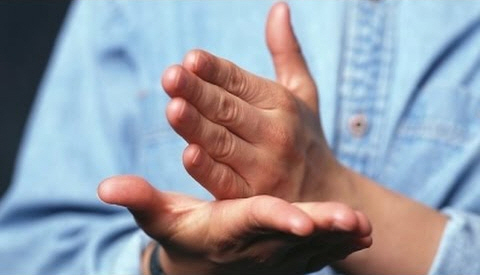
The hand chopping gesture demonstrates clear conviction
Releasing Internal Energy
If you ever noticed yourself drumming your fingers, pulling your earlobe, touching your face, or scratching your head when you haven't got an itch, you're experiencing displacement activities. Displacement activities are easy to spot because they are the small, inconsequential gestures you make when you're feeling inner turmoil or frustration.
People who are experiencing frustration, internal conflict, or boredom often feel the need to take action. If they struggle to find an appropriate action to address the source of annoyance they fill the void with meaningless activities to keep themselves busy.
Drumming Fingers
If you're in a meeting and someone's drumming his or her fingers on the table, pay attention. This person is telling you something. Bored, frustrated, or even irritated; the percussionist is impatient.
Ed works for an international law firm. Ed reveals his state of mind by the tempo of his constant finger tapping during meetings. When he's bored he drums the four fingers of his right hand in quick succession. When he's thoughtfully considering a suggestion he quietly taps his middle finger. When he's prepared to conclude the meeting he knocks his knuckles on the table. Without saying a word his colleagues know what Ed's thinking.
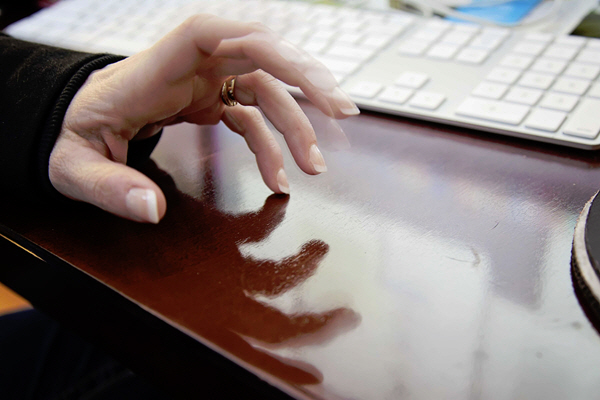
Tapping in a rhythm
Fidgeting Around
Notice what you do the next time you feel bored or anxious. Chances are you'll fidget with an object. You may jangle your keys, twist a ring on your finger, or adjust your clothes. You may also touch yourself by picking at your nails, tugging your earlobe, rubbing your cheek, or running your fingers through your hair. The purpose of these actions is to ease any nervous excess energy you may be feeling. These actions are sometimes referred to as 'adaptors' because they help you adapt to your internal tension. Adaptive behaviors tend to mainly focus on the head, face, and hands.
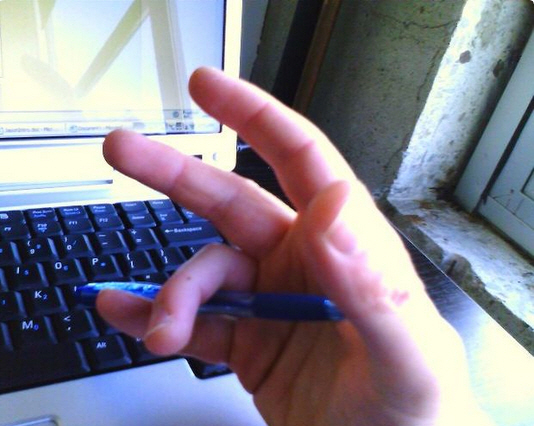
Idly spinning a pen to burn off energy
Unconsciously you may find yourself stroking your face, running your fingers over your lips, or rubbing the back of your neck when you're feeling upset. These hand gestures are reminiscent of those your mother may have used to comfort you when you were a child.
Biting Fingernails
If you ever work in intelligence you're told to observe people's mannerisms. Mannerisms are a sure sign to a person's state of being and are more difficult to disguise than facial features. Mannerisms are so entrenched that eliminating them is hard, whereas facial features can be fairly easily changed. During any assessment of another person look to her hands to see what they're like.
Doctors examine a patient's fingernails with the same amount of care and attention as they look at the face and the eyes. Any irregularity, including shape and color, is evidence of physical poor health and psychological stress and anxiety.
An Analysis of Handshake Styles
Few people ever consider how their hands behave or the way they shake hands when they meet someone. Yet that hand contact and whatever subsequent number of hand pumps that may occur establish whether dominance, submission or power plays will take place.
Shaking hands is a relic of our ancient past. Whenever primitive tribes met under friendly conditions, they would hold their arms out with their palms exposed to show that no weapons were being held or concealed. In Roman times, the practice of carrying a concealed dagger in the sleeve was common so for protection the Romans grasped the lower arm as a common greeting.
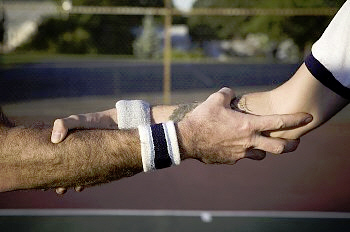
Romans used this greeting style to check for concealed weapons under clothing
The modern form of this ancient greeting ritual is the interlocking and shaking of the palms and was originally used in the nineteenth century to seal commercial transactions between men of equal status. It has become widespread only in the last hundred years or so and has always remained in the male domain until recent times. In most Western and European countries today it is performed both on initial greeting and on departure in all business contexts, and increasingly at parties and social events by both women and men.
Even in places such as Japan, where bowing is the traditional greeting, and Thailand, where they greet using the Wai - a gesture that looks similar to praying - the modern handshake is now widely seen. In most places, the hands are normally pumped five to seven times but in some countries, for example Germany, they pump two or three times with an additional hold time equal to an extra two pumps. The French are the biggest glad-handers, shaking on both greeting and departure and spending a considerable time each day shaking hands.
Deciding Who Reaches Out First
Although shaking hands when meeting another person for the first time is customary, in some instances making the first move may not be appropriate. For example, if you've forced the meeting or the other person is uncomfortable in your presence it would be inappropriate for you to extend your hand as a sign of trust and welcome. Yet if you consider the person you're meeting to be your equal and you're both glad to see one another, you simultaneously extend your hands in greeting.
When you show up at a customer without having been invited wait to see if she extends her hand in welcome. If you put your hand out first she may feel forced to shake your hand, creating a negative feeling. If no handshake is forthcoming, give a small nod of your head instead.
Because some people aren't sure whether or not to shake a woman's hand in a business context, the woman should extend her hand first to show that she's comfortable to shake hands. That way avoids wondering and fumbling.
How Dominance and Control Are Communicated
Considering what has already been said about the impact of the Palm-Up and Palm-Down gestures, let's explore their relevance in handshaking.
In Roman times, two leaders would meet and greet each other with what amounted to a standing version of modern arm wrestling. If one leader was stronger than the other, his hand would finish above the other's hand in what became known as the Upper Hand position.
Let's assume that you have just met someone for the first time and you greet each other with a handshake. One of three basic attitudes is subconsciously transmitted:
- Dominance: 'He is trying to dominate me. I'd better be cautious.'
- Submission: 'I can dominate this person. He'll do what I want.'
- Equality: 'I feel comfortable with this person.'
These attitudes are sent and received without our being aware of them, but they can have an immediate impact on the outcome of any meeting. With some practice in applying handshake techniques based on knowledge of how they are subconsciously interpreted you can dramatically influence any face-to-face meeting.
Dominance is transmitted by turning your hand so that your palm faces down in the handshake (see below). Your palm doesn't have to face directly down, but is the upper hand and communicates that you want to take control of the encounter.
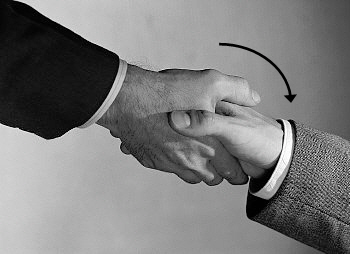
Taking control
A study of 400 senior management executives (90% men) revealed that not only did almost all of the managers initiate the handshake, 90% of the men and 30% of the women also used the dominant handshake position. Power and control issues are generally less important to women, which probably accounts for why only one in three women attempted the upper hand ritual. Some women it was found will give men a soft handshake in some social contexts to imply submissiveness. This is a way of highlighting their femininity or implying that domination of her may be possible. In a business context, however, this approach can be disastrous for a woman because men will give attention to her feminine qualities and not take her seriously. Women who display high femininity in business meetings are not taken seriously by other business women or men, despite the fact that it's now fashionable or politically correct to say everyone is the same. This doesn't mean a woman in business needs to act in a masculine way; she simply needs to avoid signals of femaleness such as soft handshakes, short skirts and high heels if she wants equal credibility.
In 2001, William Chaplin at the University of Alabama conducted a study into handshakes and found that extroverted personalities use firm handshakes while shy, neurotic personalities don't. Chaplin also found that women who are open to new ideas used firm handshakes. Men used the same handshakes whether they were open to new ideas or not. So it makes good business sense for women to practice firmer handshakes, particularly with men.
The Submissive Handshake
The opposite of the dominant handshake is to offer your hand with your palm facing upwards (as the man below on the right is doing), symbolically giving the other person the upper hand, like a dog exposing its throat to a superior dog.
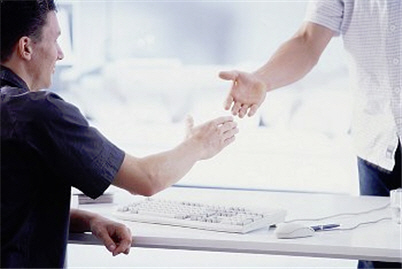
The submissive handshake
This can be effective if you want to give the other person control or allow him to feel that he is in charge of the situation if for example, you were making an apology.
While the palm-up handshake can communicate a submissive attitude, there are sometimes other circumstances to consider. A person with arthritis in their hands may be forced to give you a limp handshake because of their condition and this makes it easy to turn their palm into the submissive position. People who use their hands in their profession, such as surgeons, artists and musicians, may also give a limp handshake, purely to protect their hands. The gesture clusters they use following their handshake will give further clues for your assessment of them - a submissive person will use more submissive gestures and a dominant person will use more assertive gestures.
How to Create Equality
When two dominant people shake hands, a symbolic power struggle takes place as each person attempts to turn the other's palm into the submissive position. The result is a vice-like handshake with both palms remaining in the vertical position and this creates a feeling of equality and mutual respect because neither is prepared to give in to the other.
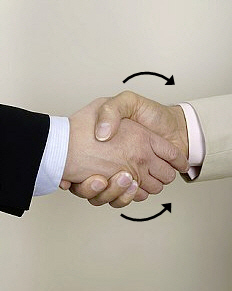
Communicating equality
How to Create Rapport
There are two key ingredients for creating rapport in a handshake. First, make sure that yours and the other person's palms are in the vertical position so that no one is dominant or submissive. Second, apply the same pressure you receive. This means that if, on a firmness scale of 1-10, your handshake registers a 7 but the other person is only a 5, you'll need to back off 20% in strength. If their grip is a 9 and yours is a 7, you'll need to increase your grip by 20%. If you were meeting a group of ten people, you'd probably need to make several adjustments of angle and intensity to create a feeling of rapport with everyone and to stay on an equal footing with each person. Also keep in mind that the average male hand can exert around twice the power of the average female hand, so allowances must be made for this. Evolution has allowed male hands to exert a grip of up to 100 pounds (45kg) for actions such as tearing, gripping, carrying, throwing and hammering.
Remember that the handshake evolved as a gesture to say hello or goodbye or to seal an agreement so it always needs to be warm, friendly and positive.
How to Disarm a Power Player
The palm down presentation is reminiscent of the Nazi salute and is the most aggressive of all handshakes because it gives the receiver little chance of establishing an equal relationship. This handshake is typical of the overbearing, dominant person who always initiates it, and their stiff arm with palm facing downwards forces the receiver into the submissive position.
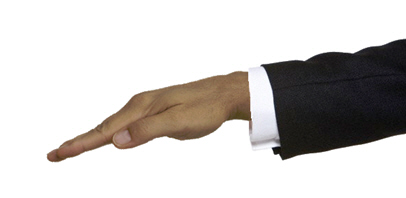
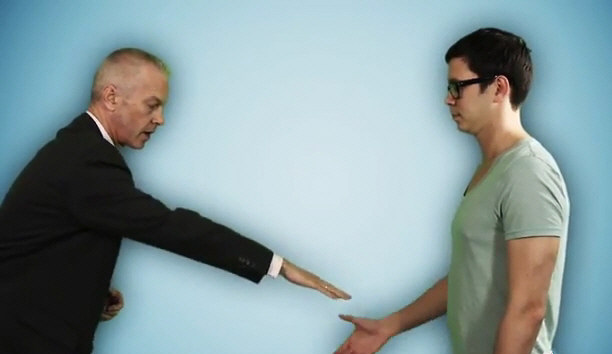
The power player attempts to control by extending his hand, palm down, for a handshake
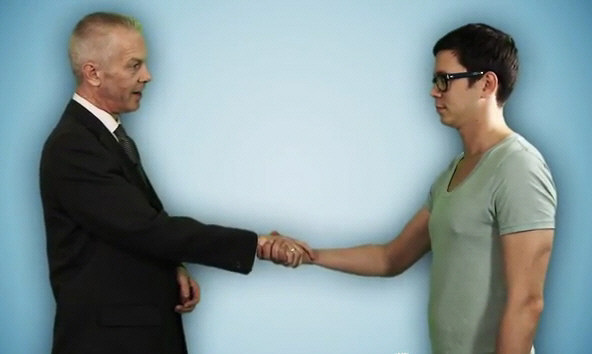
The power player makes contact, starting the dominant handshake as he expects
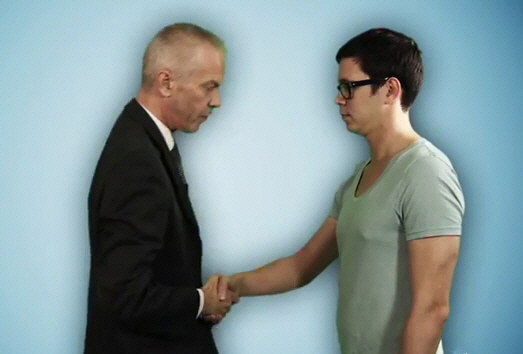
The person in the submissive position initially with his palm up steps forward on his left foot and towards his own right, beginning to move across the power player's personal space
Next, step forward with your right leg, moving across in front of the person and deeper into his personal space (marginally off to the power player's left hand side). This forces the power player's hand close to his body in front of him. Due to the structure and mechanics of the arm and shoulder, particularly for men, the power player's hand must rotate to a vertical orientation. This tactic allows you to re-orient the handshake with palms vertical, creating equal power between both people. By merely entering the power player's personal space, one achieves a greater degree of control over the encounter.
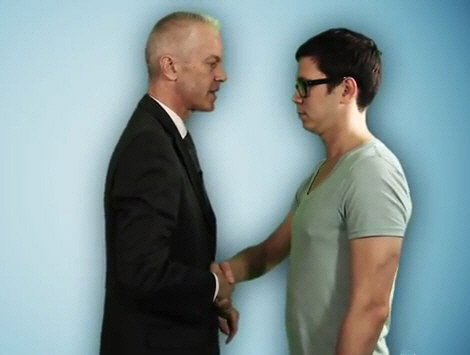
Walk across in front with your right leg and turn his palm sideways to execute a handshake with both people having equal control
Analyze your own approach to shaking hands and notice whether you step forward on your left or right foot when you extend your arm to shake hands. Most people are right footed and are therefore at a disadvantage when they receive a dominant handshake because they have little room to move and it allows the other person to dominate. Practice stepping into a handshake with your left foot and you will find that it is easier to deal with the power players who would try to control you.
2. The Hand-on-Top Technique
When a power player presents their hand to you with their palm down, respond with your hand in the palm up position then put your left hand over his right to form a double hand and straighten the handshake.
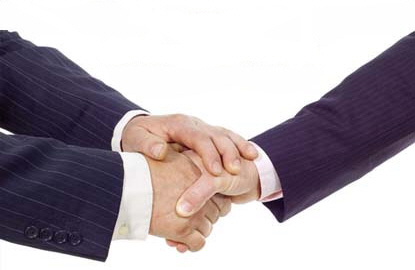
The double hand handshake
This switches the power from him to you and is a much simpler way of dealing with the situation, and is much easier for women to use. If you feel the power player is purposefully trying to intimidate, and he does it regularly, grasp his hand on top and then shake it (as below). This can shock a power player so you need to be selective when using it and do it only as a last resort.

A wrist hold as a last resort
Taking The Left Side Advantage
The next time you look at a photograph of two leaders standing next to one another see if one looks more dominant than the other. Chances are that you perceive the person on the left side of the picture to have the edge. If the photograph shows them shaking hands you can easily see that the hand of the person on the left is in the upper position, making her appear more powerful and in control. Savvy politicians are aware of the impact this body position makes and jockey to place themselves to the right of their colleague, or adversary, in order to come out on the left in the photo.
To gain the left side advantage to make yourself appear as if you're calling the shots, position yourself to the right of the other person. If you want to increase your power play, place your left hand on your colleague's back while shaking hands. Although the other person may feel annoyed by your obvious power play, you can smile warmly, knowing that you've got the advantage.
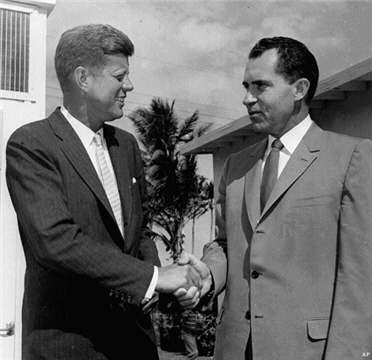
Gaining the Upper Hand - JFK using the left-hand side advantage to put Richard Nixon into the weaker-looking position
Their famous election debate revealed a remarkable testimony to the power of body language. Polls showed that the majority of Americans who listened to the debate on radio believed that Nixon was the victor but the majority of those who watched it on television believed Kennedy to be the clear winner. This shows how Kennedy's persuasive body language made the difference and eventually won him the Presidency.

Standing on the left side of the shot gives former Argentina President Cristina Kirchner the upper hand advantage over former Brazilian President Dilma Rousseff
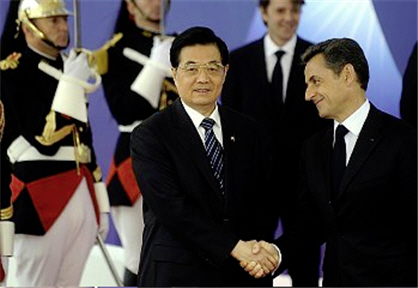
Former French President Nicolas Sarkozy approached from the wrong side - the right side of the photograph - and walking into a dominant handshake
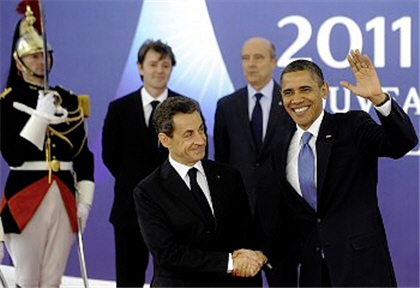
Not to be outdone this time, Nicolas Sarkozy positions himself well ... and the smile shows it!
When Men and Women Shake Hands
Even though women have had a strong presence in the workforce for several decades, many men and women still experience degrees of fumbling and embarrassment in male/female greetings. Most men report that they received some basic handshaking training from their fathers when they were boys, but few women report the same training. As adults, this can create uncomfortable situations when a man reaches first to shake a woman's hand but she may not see it - she's initially more intent on looking at his face. Feeling awkward with his hand suspended in mid-air, the man pulls it back hoping she didn't notice but as he does, she reaches for it and is also left with her hand dangling in a void. He reaches for her hand again and the result is a mish-mash of tangled fingers that look and feel like two eager squid in a love embrace.
If this ever happens to you, intentionally take the other person's right hand with your left, place it correctly into your right hand and say with a smile 'Let's try that again!' This can give you an enormous credibility boost with the other person, because it shows you care enough about meeting them to get the handshake right. If you are a woman in business, a wise strategy is to give notice to others that you intend to shake hands so as to not catch them off guard. Hold your hand out as early as possible to give clear notice of your intention to shake hands and this will avoid any fumbling.
The Double Hand Handshake
The double-hander is a favorite in the corporate and political arena. Through this particular handshake, the initiator aims to portray sincerity, honesty, and a deep feeling for the receiver. By using it you increase the amount of physical contact and by restricting the receiver's right hand you gain control of the interaction. Ideally, this handshake should only be used where a personal relationship already exists.
If someone thrusts his hand towards you, palm facing downwards, and grabs your hand in his putting you in a submissive position with little chance of balancing the equation, what do you do? Allow the power player to take your hand with your palm facing upwards. Then, before he knows what you're up to, put your left hand on top of his right to create a double-hander. From this position you're able to straighten the handshake and gain control subtly and effectively.
When you use the two-handed handshake, the left hand conveys two points worth noting. Firstly, it reveals the intensity of feeling you're demonstrating towards the receiver. This is a complex movement in that the gesture shows both the degree of connection you have with the receiver as well as the amount of control you're exerting. The second point is that your left hand invades the receiver's personal space. Unless the receiver has positive feelings for you this gesture can lead to feelings of suspicion and mistrust. If in doubt, don't use it; especially on an executive above you.
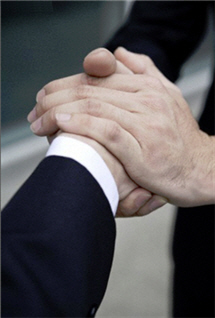
The double hander
This handshake increases the amount of physical contact given by the initiator and gives control over the receiver by restricting his right hand. Sometimes called the 'politician's handshake', the initiator of the double hander tries to give the impression he is trustworthy and honest, but when it's used on a person he's just met, it can have the reverse effect leaving the receiver feeling suspicious about the initiator's intentions. The double hander is like a miniature hug and is acceptable only in circumstances where a hug could also be acceptable.
Ninety per cent of humans are born with the ability to throw the right arm in front of the body - known as an over-arm blow - for basic self-defense. The double hander restricts this defense capability, which is why it should never be used in greetings where a personal bond doesn't exist with the other person. It should be used only where an emotional bond already exists, such as when meeting an old friend. In these circumstances, self-defense is not an issue so the handshake is perceived as genuine.
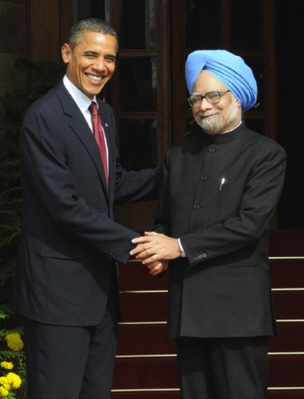
Barack Obama on the receiving end of a double hand handshake
Handshakes of Control
The intention of any two-handed handshake is to try to show sincerity, trust or depth of feeling for the receiver. Two significant elements should be noticed. Firstly, the left hand is used to communicate the depth of feeling the initiator wants to convey and this is relative to the distance the initiator's left hand is placed up the receiver's right arm. It's like an intention to embrace and the initiator's left hand is used like a thermometer of intimacy - the further up the receiver's arm it's placed, the more intimacy the initiator is attempting to show. The initiator is both attempting to show an intimate connection with the receiver while, at the same time, attempting to control their movement.
For example, the elbow grasp handshake conveys more intimacy and control than the wrist hold handshake, and the shoulder hold handshake conveys more than the upper arm grip.

The wrist hold
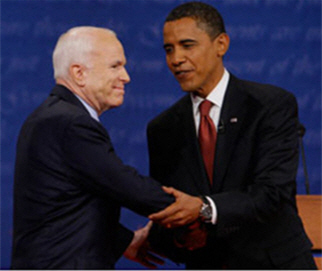
The elbow grasp
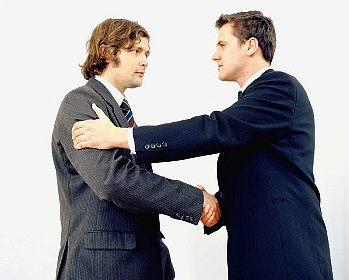
The upper arm grip
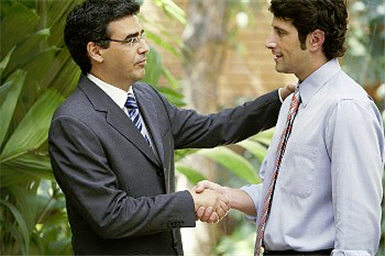
The shoulder hold
Secondly, the initiator's left hand is an invasion of the receiver's personal space. In general, the wrist hold and elbow grasp handshakes are acceptable only where one person feels close to the other and in these cases the initiator's left hand enters only the outer edge of the receiver's personal space. The shoulder hold and upper arm grip handshakes show close intimacy and may even result in a hug. Unless the intimate feelings are mutual or the initiator doesn't have a good reason for using a double-handed handshake, the receiver will probably be suspicious and mistrust the initiator's intentions. In summary, if you don't have some sort of personal bond with the other person, don't use any double handed handshake. And if the person who gives you one doesn't have a personal connection with you, look for their hidden agenda.
It's common to see politicians greeting voters using double handed handshakes and business people doing it to clients without realizing it can be business and political suicide, putting people offside.
The Space Invader
Whether you're pulling someone into your territory when shaking hands or you're invading their space by plunging your arm into their terrain, a power play is taking place and you hold the power.
In the first instance, you propel your arm forward, forcefully grip the receiver's extended hand, and simultaneously go into a quick reverse thrust, yanking them into your space and huddling over the handshake until you're ready to let it go. If you pull someone into your personal space you create a handshake on your terms. You're in charge.
Be aware of the amount of force you apply or you may find the other person falling on top of you as you pull them in. That's what you call getting the relationship off on the wrong foot!
If you invade the other person's territory you extend your arm fully, forcing the other person to retreat back into their domain. Their arm ends up in a cramped position while your extended arm fills their space.
The Delayed Handshake - Putin Power Play?
It is arguable what international expansionist intentions Vladimir Putin has or has not had during his Russian Presidency. His relationship and attitudes to the western world can be intuited through his interactions with leaders in public forums. Here are Putin and President Obama interacting at a United Nations General Assembly in 2015. A reasonable interpretation is that of a superior sizing up an inferior opponent.
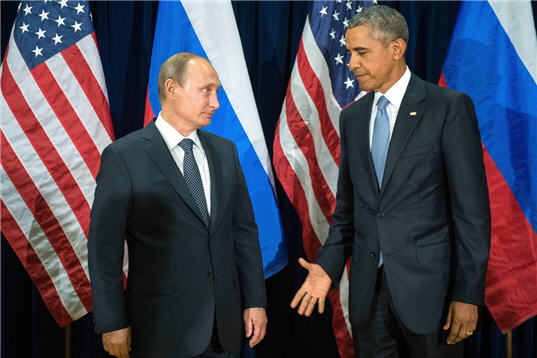
Is Putin bemused or showing outright disdain for Obama?
Handshake Styles That Could Improve
Here are some of the more annoying and disliked handshakes and their variations. Avoid them as best you cans:
1. The Wet Fish
If you've ever been presented with a totally limp hand to shake you know how unconnected it feels when your hands meet. People who refuse to commit to a handshake tend to be self-important and aloof. Granted, surgeons and concert pianists need to guard their fingers and are known for their soft handshakes. And people who have to do a lot of shaking also offer a relaxed hand in order to protect their fingers.
Some people offer the uncommitted handshake for other reasons. Some women think that it's appealing to present themselves as submissive to both men and women. Very strong people sometimes offer a soft handshake as a way of highlighting their physical power. If a person's lacking in confidence she also holds back from making a connection.
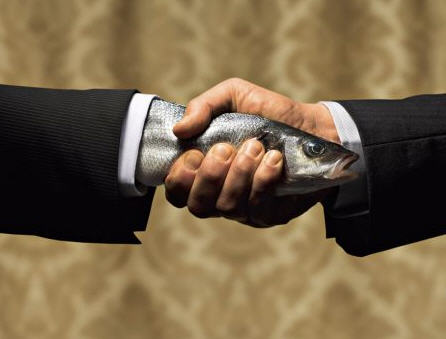
The wet fish
The palms have more sweat glands than any other part of the body, which is why sweaty palms become so obvious. Surprisingly, many people who use the wet fish style are unaware they do it so it's wise to ask your friends to comment on your handshake style before deciding what you'll use in future meetings.
2. The Vice Grip
This quietly persuasive style is a favorite of men in business and reveals a desire to dominate and assume early control of the relationship or put people in their place. The palm is presented in the down position with one sharp downward pump followed by two or three vigorous return strokes and a grip that can even stop blood flow to the hand. Sometimes it will be used by a person who feels weak and fears they will be dominated by others.
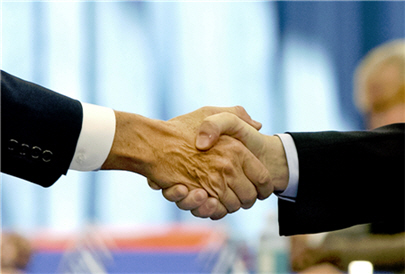
The vice grip
3.The Knuckle Cruncher
A step up in assertiveness from the vice grip. Before you can stuff your hand in your pocket the knuckle cruncher is there, turning your knuckles into pulverized bone. These people seem to have an overly aggressive attitude to compensate for ineffectiveness in other areas of their life. The person that delivers a knuckle cruncher is to be avoided as there is little that a recipient of this hand shake can do to counter or mitigate the damage.
To avoid this potentially painful handshake both men and women should avoid wearing rings on your right hands in a business context.
Unfortunately, there are no effective physical ways to counter it. If you think that your hand has been purposely crunched say 'Wow! That's one strong grip you have there!'. You're letting the person know that you're onto their game. This has even more impact if other people are present observing the interaction. They're unlikely to try that trick again.
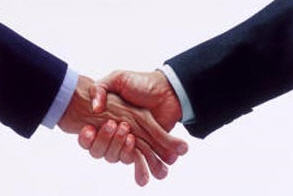
The bone cruncher handshake
4. The Finger Tip Grab
A common occurrence in male-female greetings, the finger tip grab is a handshake that missed the mark and the user mistakenly grabs the other person's fingers. Even though the initiator may seem to have an enthusiastic attitude towards the receiver, he in fact lacks confidence in himself. In these circumstances, the main aim of the finger tip grab is to keep the receiver at a comfortable distance. The finger tip grab can also result from personal space differences between the people in the handshake. This could happen if one person's intimate space was two feet (60cm) and the other's was three feet (90cm), the latter stands further back during greeting so the hands don't connect properly.
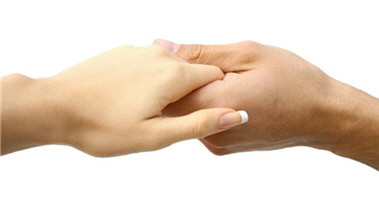
The finger tip grab
If this happens to you, take the other person's right hand with your left and place it correctly in your right hand and say, with a smile 'Let's try that again!' and shake hands equally. This builds your credibility because you are telling the other person that you think they are important enough for you to get it right.
5. The Stiff Arm Thrust
Like the palm down presentation, the stiff arm thrust tends to be used by aggressive types and its main purpose is to keep you at a distance and away from their personal space. It's also used by people raised in rural areas, who have larger personal space needs and want to protect their territory.
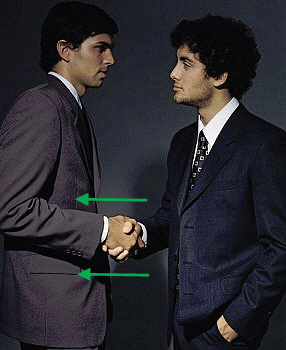
The stiff arm thrust
These people will even lean forward or balance on one foot to keep their distance when delivering a stiff arm thrust.
6. The Socket Wrencher
A popular choice of power players and common cause of watering eyes and, in extreme cases, torn ligaments. This is the father of the bent arm pull in, and involves forcefully gripping the receiver's outstretched palm, then simultaneously applying a sharp reverse thrust, attempting to drag the receiver into the initiator's territory. This results in loss of balance and gets the relationship off on the wrong foot.
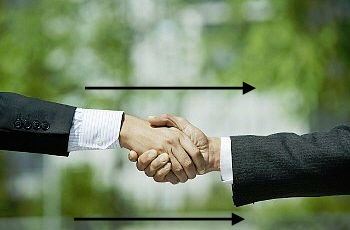
The socket wrencher
Pulling the receiver into the initiator's territory can mean one of three things: first, the initiator is an insecure type who feels safe only within his own personal space; second, the initiator is from a culture that has smaller space needs; or third, he wants to control you by pulling you off balance. Either way, he wants the encounter to be on his terms.
7. The Water Pump
With strong rural overtones, the pumper grabs the other's hand and commences energetically and rhythmic series of rapid vertical strokes. While up to seven pumps is acceptable, some pumpers continue to pump uncontrollably as if they are trying to draw water from the pumpee.
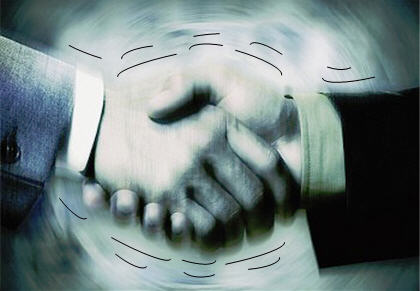
The pump handle handshake
Occasionally, the pumper will cease pumping but continue to hold the receiver's hand to prevent their escape and, interestingly, few people try to pull their hand away. The act of being physically connected seems to weaken our resolve to retreat.
The Arafat-Rabin Handshake
The photograph below shows the late Israeli Prime Minister, Yitzhak Rabin and Palestinian Chairman Yassar Arafat shaking hands at the White House in 1993 and it reveals several interesting attitudes. President Clinton is, in fact, the key figure in the shot because of his unobstructed center position, extra height and arms spread with open palms gesture, reminiscent of a god presiding over his people.

Yitzhak Rabin (left) holds his ground using a stiff arm to resist being pulled forward by Yassar Arafat
In this famous shot, both men keep their feet firmly planted on the ground and attempt to force the other out of his territory - Yitzhak Rabin assumed the power position on the left side of the picture and used a stiff arm thrust and leaned forward to keep Arafat out of his personal space while Yassar Arafat stood absolutely erect and attempted to counter with a bent arm pull in.
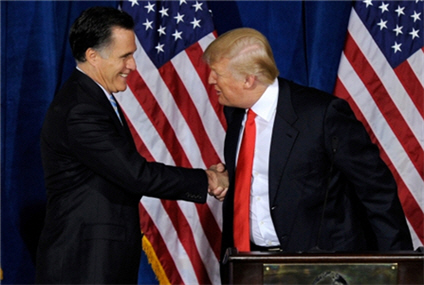
President Donald Trump is not shy making his move on former US presidential candidate Mitt Romney
Summary
Few people have any idea how they come across to others in initial meetings, despite the fact that most of us are aware that the first few minutes of that meeting can make or break a relationship. Take the time to practice handshake styles with your friends and colleagues and you can quickly learn how to deliver a positive handshake every time. Keeping the palms held vertical and matching the other person's grip is usually perceived as a 10/10 handshake.



